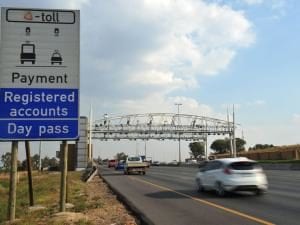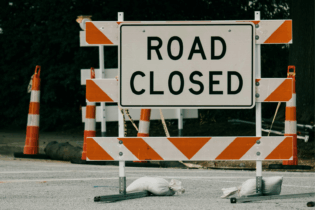South Africans are paying millions of rands extra for toll roads as a group of powerful players reap the spoils of lucrative tenders from the SA Roads Agency (Sanral), while cheaper options are ignored.
A court will hear arguments for and against the proposed tolling of Gauteng roads this week. Court papers lodged by the Opposition to Urban Tolling Alliance slam Sanral, saying the Gauteng e-toll plan is “unlawful” and “disproportionately and unjustifiably expensive”, while accusing the roads agency of a shameless lack of transparency. This view is supported by a three-month Sunday Times investigationc into the toll industry. It appears to operate under a cloud, with sub-contractors reluctant to criticise economically unsound decisions by Sanral, fearing they will be excluded from further deals worth billions. Our investigation has established that:- Sanral boss Nazir Alli has signed off a series of deals that appear to benefit an “old boys'” network – specifically Tolplan boss Willie Pienaar and N3 Toll Consortium MD Neil Tolmie – while cheaper bids from new entrants are ignored;
- Tolplan is controlled by Pienaar, who first carried out “policy studies” in 1982 that recommended tolling SA’s roads. Yet, Tolplan has made a killing by doing feasibility studies on tolling those roads, adjudicating on tenders and, finally, scoring engineering work on the same roads;
- Tolplan fired director Lennox Matshaya this month after he accused them of BEE “fronting”. Though Matshaya claims Tolplan made billions from Sanral, the company won’t say how much it has earned – even going to court to gag Matshaya from speaking to the press. When asked how much Sanral paid Tolplan, Alli told the Sunday Times: “It’s got nothing to do with you”;
- In just three deals clinched between 2009 and 2011 – the N1 north in Limpopo, the N1 south in Gauteng and the Free State, and the N2 north in KwaZulu-Natal – road users are paying R186-million more than they should because Sanral insisted on using a subcontractor with prior business links to Pienaar, Tollink. This is despite numerous gripes that the Tollink electronic system that records toll traffic is prone to crashing and losing data;
- The N3 from Johannesburg to Durban was awarded to the N3 Toll Consortium in 1998 only after the tender adjudicator, Tolplan, “revised” its score on one element to favour the consortium, after handwritten comments were made on the tender evaluation by Tolmie, who was Sanral manager at the time. He later quit to become CEO of the N3TC. Tender documents confirm that Schabir Shaik’s company, Nkobi Holdings, was a 3% shareholder of the N3TC when it won the bid. Tolmie said there was “no basis” for alleging any wrongdoing on his part;
- Sanral and the N3TC collected R2.2-billion in toll fees on the N3 highway in 2009 and 2010 alone, yet the consortium insists on keeping its financials secret;
- Electronic Toll Collection (ETC), the firm majority-owned by Austrian company Kapsch, won the tender to operate the Gauteng tolls for R9.9-billion in 2008, boasting 18% black empowerment. But it is estimated that ETC will make far more, while its BEE shareholding has shrunk to 5.8% as Moss Mashishi’s Matemeku has sold most of its shares to Kapsch; and
- Motorists will pay at least R71-billion in Gauteng tolls over the next 24 years while operators like ETC will get at least R18-billion of that in fees.
“Many [clients] see an advantage in having the same company involved from a continuity point of view,” he said.
Pienaar often technically complies with governance rules by quitting a company shortly before it lands a major Sanral contract. He was a shareholder and director of engineering consultancy BKS until he resigned in April 1997, three months after the N3 tender opened. His company, Tolplan, then adjudicated on bids for the N3 tender, recommending that the N3TC be awarded the R5.4-billion contract. However, BKS is a member of the N3TC. Pienaar said: “It was precisely to eliminate the conflict of interest that could have arisen … that I resigned from BKS in April 1997.” Meanwhile, Tollink repeatedly scores multimillion-rand Sanral tenders adjudicated on by Tolplan. In the case of three toll roads – the N2 north in KwaZulu-Natal, the N1 south in Gauteng and the Free State, and N1 North in Limpopo – Sanral awarded tenders to companies that were forced to use the Tollink electronic toll system, despite providing alternative options that were R186-million cheaper. In one deal, Murray & Roberts subsidiary Tolcon won a R710-million tender in April 2011 to run the N1 in Limpopo for eight years, using the Tollink system. However, when Group Five subsidiary Intertoll tendered for the same project, using its in-house electronic system, for R656-million, it was unsuccessful. On the N1 south, Intertoll won the R629-million tender when it included the Tollink system, despite providing an alternative R573-million bid, using its own system. On the N2 north, Intertoll again won the tender worth R661-million, using the Tollink system, rather than their cheaper alternative of R585-million. Sanral has acknowledged Tollink’s problems in a memo. Smit said Intertoll’s in-house system was untested, and “we want a proven system”. However, Intertoll’s system has been successfully tested at the Grasmere ramp plaza. Asked why Tolplan was key to most major contracts, Smit said: “It’s a small industry.”







